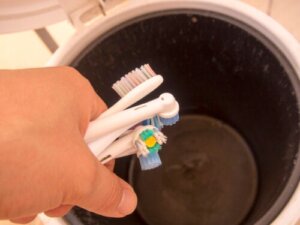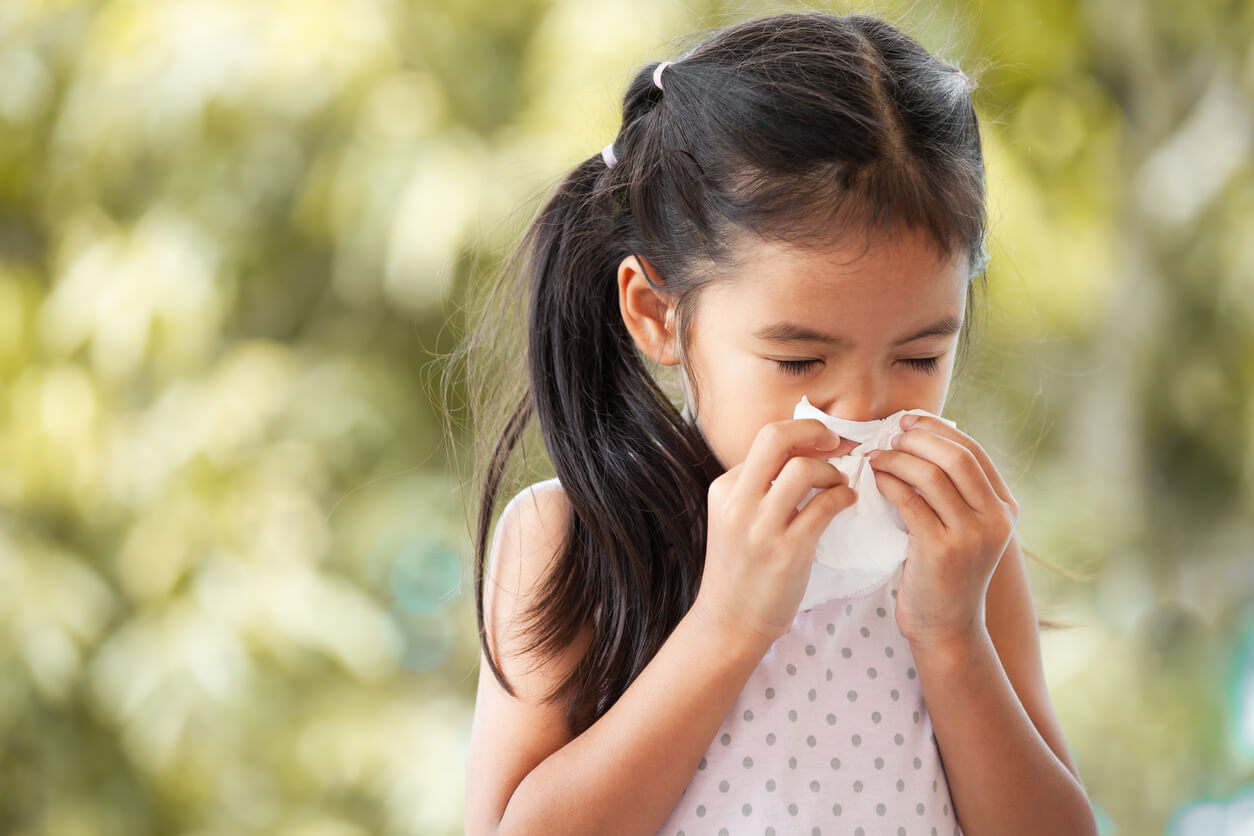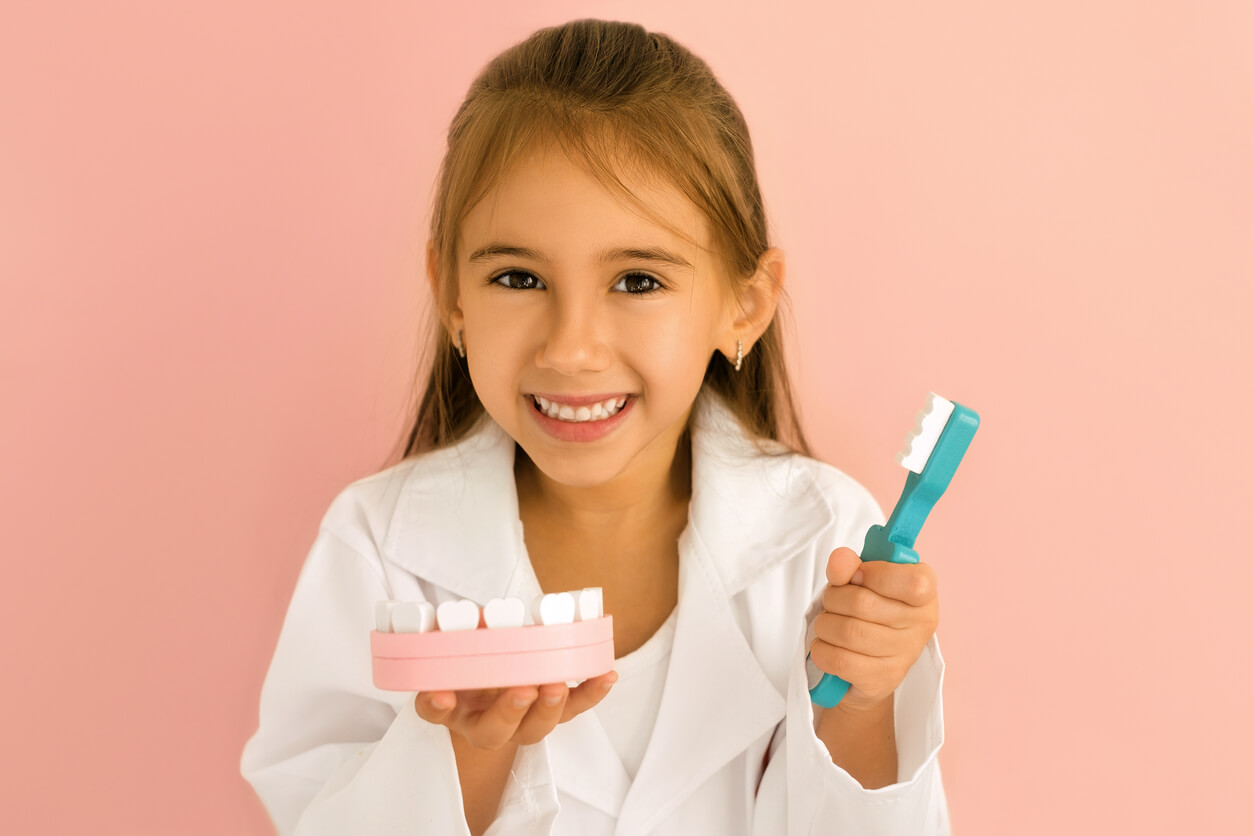Why Should You Replace a Child's Toothbrush After an Infection?

You may have heard that it’s important to change a child’s toothbrush if they’ve suffered from an infection. This advice has gained popularity especially, during the COVID-19 pandemic.
There are several reasons why it’s necessary to replace a child’s toothbrush, but after having suffered from a cold, the flu, or any infectious condition of the airways, experts recommend replacing this instrument.
In this article, we’ll analyze this suggestion in detail and tell you why you should take it into account. Find out more.
Reasons to replace a child’s toothbrush after an infection
The American Dental Association (ADA) recommends replacing your toothbrush every 3 to 4 months or when the bristles become misshapen and less effective. Also, it’s a good idea to do it after recovering from some local infectious process.
Therefore, if your children have had the flu, tonsillitis, or some other infection of the airways, it’s best to replace their toothbrushes. You may even consider buying new toothbrushes for the entire family.
This way, the proliferation of pathogenic germs among the bristles of this element is avoided and the possibilities of spreading the infectious agent are reduced.
Probably, the child who was sick won’t have problems and their immune system will defend them from getting sick from the same thing again. But the rest of the family is at risk of becoming infected.
Some germs may survive, multiply, and spread through toothbrush bristles. In many houses, all these hygiene instruments are kept in the same glass or share a common area. For this reason, it’s best to err on the side of caution and replace everyone’s toothbrushes. After all, nobody wants to put an instrument full of microbes in their mouth.
Despite this, a study presented at the American Academy of Pediatrics claims that throwing away this instrument isn’t necessary after a diagnosis of strep throat.
Finally, the recommendation to change a child’s toothbrush after an infection is especially important if the child has been hospitalized. Upon discharge, both the paste and the brush should be discarded due to the risk of hospital contamination.

Replacing your child’s toothbrush after suffering from COVID-19
With the COVID-19 pandemic, many sites and even health professionals began to suggest that parents replace the toothbrushes of children and even adults after having suffered from the infection. But for this type of condition, the same recommendations we mentioned above are valid.
If a child gets sick, their immune system produces specific antibodies that fight that strain of the virus. This defense will remain available for a while and will naturally protect them from reinfection.
That’s why, after recovery, if the virus remains on the toothbrush, it’s unlikely that the little one will get sick again. In any case, even if the child isn’t at risk, the possibility of other people becoming infected could support buying a replacement.
It’s worth clarifying that, in the case of a COVID-19 infection, studies have shown that contagion occurs more frequently through close contact with people than with a contaminated surface. According to the Centers for Disease Control and Prevention (CDC), the possibility of contracting coronavirus through surfaces is very low and depends on multiple variables.
In any case, the replacement of this hygiene instrument as a preventive and family care measure doesn’t hurt.
Toothbrush care
As we told you, the evidence suggests that replacing children’s toothbrushes after an infection isn’t entirely necessary. But the truth is that it’s a simple measure that could allow you to avoid setbacks.
A toothbrush in good condition not only prevents the proliferation and spread of germs, but also allows for effective dental hygiene.
Here are some tips to keep your toothbrushes in top condition and as germ-free as possible:
- Don’t share your toothbrush or toothpaste with anyone.
- Rinse the toothbrush with cold water after use.
- Don’t immerse the brush in disinfectant solutions or mouthwashes. This could encourage the spread of germs.
- Allow the brush to air dry in an upright position. Don’t dry it with towels.
- Don’t store it in closed containers. Humid environments favor the proliferation of bacteria and fungi.
- Change your toothbrush every 3 to 4 months, or sooner if the bristles look frayed or open.
- Avoid keeping toothbrushes in the same area. It’s best for each brush to have its own support, which is separate from that of the others.

All these tips apply to both manual toothbrushes and electric hygiene device heads. And if any of your children have suffered from an infection, our suggestion is that you change their toothbrush and replicate this with the whole family.
Keeping your toothbrush in top condition is essential for effective oral hygiene. And although a replacement very often seems unnecessary or too expensive, the gain when it comes to your family’s health is much greater.
You may have heard that it’s important to change a child’s toothbrush if they’ve suffered from an infection. This advice has gained popularity especially, during the COVID-19 pandemic.
There are several reasons why it’s necessary to replace a child’s toothbrush, but after having suffered from a cold, the flu, or any infectious condition of the airways, experts recommend replacing this instrument.
In this article, we’ll analyze this suggestion in detail and tell you why you should take it into account. Find out more.
Reasons to replace a child’s toothbrush after an infection
The American Dental Association (ADA) recommends replacing your toothbrush every 3 to 4 months or when the bristles become misshapen and less effective. Also, it’s a good idea to do it after recovering from some local infectious process.
Therefore, if your children have had the flu, tonsillitis, or some other infection of the airways, it’s best to replace their toothbrushes. You may even consider buying new toothbrushes for the entire family.
This way, the proliferation of pathogenic germs among the bristles of this element is avoided and the possibilities of spreading the infectious agent are reduced.
Probably, the child who was sick won’t have problems and their immune system will defend them from getting sick from the same thing again. But the rest of the family is at risk of becoming infected.
Some germs may survive, multiply, and spread through toothbrush bristles. In many houses, all these hygiene instruments are kept in the same glass or share a common area. For this reason, it’s best to err on the side of caution and replace everyone’s toothbrushes. After all, nobody wants to put an instrument full of microbes in their mouth.
Despite this, a study presented at the American Academy of Pediatrics claims that throwing away this instrument isn’t necessary after a diagnosis of strep throat.
Finally, the recommendation to change a child’s toothbrush after an infection is especially important if the child has been hospitalized. Upon discharge, both the paste and the brush should be discarded due to the risk of hospital contamination.

Replacing your child’s toothbrush after suffering from COVID-19
With the COVID-19 pandemic, many sites and even health professionals began to suggest that parents replace the toothbrushes of children and even adults after having suffered from the infection. But for this type of condition, the same recommendations we mentioned above are valid.
If a child gets sick, their immune system produces specific antibodies that fight that strain of the virus. This defense will remain available for a while and will naturally protect them from reinfection.
That’s why, after recovery, if the virus remains on the toothbrush, it’s unlikely that the little one will get sick again. In any case, even if the child isn’t at risk, the possibility of other people becoming infected could support buying a replacement.
It’s worth clarifying that, in the case of a COVID-19 infection, studies have shown that contagion occurs more frequently through close contact with people than with a contaminated surface. According to the Centers for Disease Control and Prevention (CDC), the possibility of contracting coronavirus through surfaces is very low and depends on multiple variables.
In any case, the replacement of this hygiene instrument as a preventive and family care measure doesn’t hurt.
Toothbrush care
As we told you, the evidence suggests that replacing children’s toothbrushes after an infection isn’t entirely necessary. But the truth is that it’s a simple measure that could allow you to avoid setbacks.
A toothbrush in good condition not only prevents the proliferation and spread of germs, but also allows for effective dental hygiene.
Here are some tips to keep your toothbrushes in top condition and as germ-free as possible:
- Don’t share your toothbrush or toothpaste with anyone.
- Rinse the toothbrush with cold water after use.
- Don’t immerse the brush in disinfectant solutions or mouthwashes. This could encourage the spread of germs.
- Allow the brush to air dry in an upright position. Don’t dry it with towels.
- Don’t store it in closed containers. Humid environments favor the proliferation of bacteria and fungi.
- Change your toothbrush every 3 to 4 months, or sooner if the bristles look frayed or open.
- Avoid keeping toothbrushes in the same area. It’s best for each brush to have its own support, which is separate from that of the others.

All these tips apply to both manual toothbrushes and electric hygiene device heads. And if any of your children have suffered from an infection, our suggestion is that you change their toothbrush and replicate this with the whole family.
Keeping your toothbrush in top condition is essential for effective oral hygiene. And although a replacement very often seems unnecessary or too expensive, the gain when it comes to your family’s health is much greater.
All cited sources were thoroughly reviewed by our team to ensure their quality, reliability, currency, and validity. The bibliography of this article was considered reliable and of academic or scientific accuracy.
- American Academy of Pediatrics. (2013, May 4). Don’t be quick to toss your toothbrush after a sore throat. ScienceDaily. Retrieved March 21, 2022 from www.sciencedaily.com/releases/2013/05/130504163304.htm
- Mandujano Trujillo, Y. (2018). Grado de contaminación microbiana de los cepillos dentales guardados en el baño y dormitorio de los estudiantes de Odontología de la Universidad de Huánuco 2017.
- Jacqueline, A., & Cabezas, C. (2021). Medidas de prevención de la transmisión microbiológica en el almacenamiento de cepillos dentales (Bachelor’s thesis, Universidad Nacional de Chimborazo).
- Vásconez Rojas, M. B. (2014). Estudio en vitro de los microorganismos presentes en el cepillo dental y su relación con las enfermedades, en los estudiantes de quinto año de la escuela de educación básica fiscal “leopoldo freire”, de la parroquia matriz, del cantón chambo, periodo mayo-agosto del 2014 (Bachelor’s thesis, Riobamba: Universidad Nacional de Chimborazo, 2014.).
- Lewis, D. (2021). COVID-19 rarely spreads through surfaces. So why are we still deep cleaning. Nature, 590(7844), 26-28.
- Gaviria, P. A., Rosales, H. L., & Contreras, A. (2000). Contaminación in vitro de cepillos dentales. Revista Estomatología, 9(2).
- Contreras, A., Arce, R. M., Botero, J. E., & Jaramillo, A. (2002). Contaminación bacteriana de cepillos dentales en niños y sus padres: una cuestión de educación.
This text is provided for informational purposes only and does not replace consultation with a professional. If in doubt, consult your specialist.








